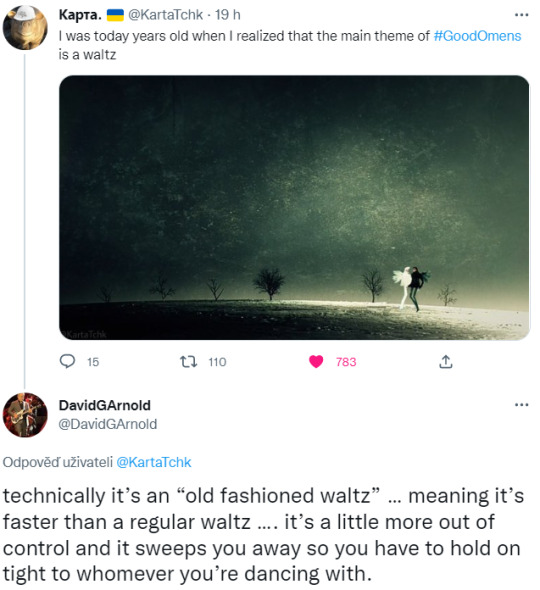#307 posts :D
Explore tagged Tumblr posts
Text
Hello Tumbler! Uh, is that how an intro works? I’m 307, and I made an account on this site because I saw that Isopod visited it a lot and I think it would be fun to have :0 I’m sharing this other with the other longterm wing kids… I should probably tell them that. Add more later! Buh-bye!
Hey. Uh. Arven here. Tri said I could post art on here, I might post paintings. Probably only going to hoard writing tips and aesthetic pictures, supposedly that’s what Isopod used this website for when I was their age and that sounds pretty fun? I suppose?
307 back again! You guys can call me Tri, most do! I’m just a fun happy creature, I collect plushies and uh…. Hang out with my friends! Yeah! I SHOULD GET MY BOYFRIEND TO MAKE HIS INTRO I’M OFF TO DO THAT
Tri is real excited about this, I’m having her type stuff out because the keyboard is too warm right now… anyways, my name is Celsius, call me whatever, I like roller coasters, architechture, whatever old scifi books I can get my paws on, and Tri, my wonderful partner! God I- HEY DON’T ADD MY GUSHING TO THIS I CAN SEE YOU GIGGLING AND TYPING IT
Mimi here! I’m gonna use this to find fandom friends, post edits, y’know, be a real internet kid! I might try posting music here too… we’ll see!!!! One of these days I’m gonna get everyone their own little sets of borders and stamps and silly graphics but it’s 1 am and Tri’s staring at me with that “please hurry up so I can pass this to the next room” face so BAI!!!!! (^ω^)
Ossi here. Uh… I’ll use this? Maybe? What is this thing- hmm, Chai’s telling me it’s a social media, and that I can find sewing patterns and recipies… cool? Chai’s turn to write!
My name is Chai and I do NOT want to fucking write on this dumb blog that 307 is setting up or whatever. If I do ever post it’ll be over stuff like… I dunno, my knife collection? And my charcoal sketches maybe. But that’s UNLIKELY! DO NOT GET YOUR HOPES UP!
(OOC: HEY HI!!!! Corv here, a few rules about this blog: THESE OCS ARE TEENS! NO INNAPROPRIATE STUFF, PG13 AT BEST! This blog may contain posts about fictional medical malpractice/abuse, trauma, mild gore… if you can’t take that, it’s ok! We’ll be triggertagging the shit out of those posts, and you can always just not read this blog if that’s not your vibe!)
(if you want to send asks, please clarify which character/s they’re for! Askbox is in fact open!)
(blog theming info will be added here when we yknow. Get to it.)
#Oc roleplay blog#intro post#in-character#307 posts :D#Arven posts.#Celsius’s chats#MIMI YIPS!!!#Ossi posts..?#NO 307 I DO NOT NEED A TAG (direct quote from Chai)
6 notes
·
View notes
Text
i. asteroid notes
*(not a pro. just for fun)
• natives with Ceres[1] (garners agriculture, nurture, nourishment, food etc.) in scorpio might feel guilty for what they deem as 'overnourishment' towards themselves instilled by their caregivers. their guardians could've told them to use small amounts of their lotions, eat less portions of food etc. so that they don't run out too quickly because money was always unstable. from what i've noticed, these natives might be picky eaters & are consistent with the type of food that they eat.
• Nike[307] (shows where you're victorious) trine/sextile/conjunct the Sun/MC could have an easier time obtaining power over others. whether it be their influence on others or falling into positons of power like being a CEO of a company.
Mark Zuckerberg has Nike conjunct the Sun in his natal chart & he's a CEO. Emma Chamberlain has it conjunct her MC & she owns a company. despite both receiving backlash & other hindering factors.
• Pholus[5154] (represents a small catalyst of decisions yielding in massive results) in transit conjunct Mercury in your natal chart is where you should be careful with your words. nonetheless, the results could be positive like posting on your socials & becoming viral.
Mercury also rules over vehicles. during this transit, i decided to take a short walk & ended up getting hit by a car lmao.
• Eros[433] (IMO represents both love & passion towards yourself & externally) square Mercury could indicate that you don't flirt or don't know how to without cringing. these natives could also have trouble with words of affirmation towards themselves & feel uncomfortable when others flirt with them especially if they don't like them.
• i checked Iris[7] (represents intuition) in celebrities charts who said they've always knew they were going to be well-known and all 3 (Jim Carrey, Oprah Winfrey, Lil Nas X) have leo degrees on their Iris. very cool observation if i do say so myself :D
(i'm aware some of these are dwarf planets)
thanks for reading :)
15/05/23
297 notes
·
View notes
Text

@rat-rosemary for some reason Tumblr wouldn’t let me reply to this ask properly, LMAO so I screenshotted it to reply to instead. Hope that’s okay!
I have been given permission to share the invite link! Be warned, it expires in a week from me posting this, so future people will Not be able to use it! (Future people, I suggest going to @the-final-sif to ask for the link as she’s the admin—Sif, Vault said I could share it)
:D glad to hear you enjoyed the fic! It was such a blast to write!
#askbox#mcyt#original bullshit#rat-rosemary#sorry it took me a while to reply! also mad that tumblr glitched#but i have food now so its chill <3
10 notes
·
View notes
Text

Section E — What do anarchists think causes ecological problems?
This section of the FAQ expands upon section D.4 (“What is the relationship between capitalism and the ecological crisis?”) in which we indicated that since capitalism is based upon the principle of “grow or die,” a “green” capitalism is impossible. By its very nature capitalism must expand, creating new markets, increasing production and consumption, and so invading more ecosystems, using more resources, and upsetting the interrelations and delicate balances that exist with ecosystems. We have decided to include a separate section on this to stress how important green issues are to anarchism and what a central place ecology has in modern anarchism.
Anarchists have been at the forefront of ecological thinking and the green movement for decades. This is unsurprisingly, as many key concepts of anarchism are also key concepts in ecological thought. In addition, the ecological implications of many anarchist ideas (such as decentralisation, integration of industry and agriculture, and so forth) has meant that anarchists have quickly recognised the importance of ecological movements and ideas.
Murray Bookchin in particular has placed anarchist ideas at the centre of green debate as well as bringing out the links anarchism has with ecological thinking. His eco-anarchism (which he called social ecology) was based on emphasising the social nature of the ecological problems we face. In such classic works as Post-Scarcity Anarchism, Toward an Ecological Society and The Ecology of Freedom he has consistently argued that humanity’s domination of nature is the result of domination within humanity itself.
However, anarchism has always had an ecological dimension. As Peter Marshall notes in his extensive overview of ecological thought, ecologists “find in Proudhon two of their most cherished social principles: federalism and decentralisation.” He “stands as an important forerunner of the modern ecological movement for his stress on the close communion between humanity and nature, for his belief in natural justice, for his doctrine of federalism and for his insight that liberty is the mother and not the daughter of order.” [Nature’s Web, p. 307 and p. 308] For Proudhon, a key problem was that people viewed the land as “something which enables them to levy a certain revenue each year. Gone is the deep feeling for nature.” People “no longer love the soil. Landowners sell it, lease it, divide it into shares, prostitute it, bargain with it and treat it as an object of speculation. Farmers torture it, violate it, exhaust it and sacrifice it to their impatient desire for gain. They never become one with it.” We “have lost our feeling for nature.” [Selected Writings of Pierre-Joseph Proudhon, p. 261]
Other precursors of eco-anarchism can be found in Peter Kropotkin’s writings. For example, in his classic work Fields, Factories and Workshops, Kropotkin argued the case for “small is beautiful” 70 years before E. F. Schumacher coined the phase, advocating “a harmonious balance between agriculture and industry. Instead of the concentration of large factories in cities, he called for economic as well as social decentralisation, believing that diversity is the best way to organise production by mutual co-operation. He favoured the scattering of industry throughout the country and the integration of industry and agriculture at the local level.” His vision of a decentralised commonwealth based on an integration of agriculture and industry as well as manual and intellectual work has obvious parallels with much modern green thought, as does his stress on the need for appropriate levels of technology and his recognition that the capitalist market distorts the development, size and operation of technology and industry. Through his investigations in geography and biology, Kropotkin discovered species to be interconnected with each other and with their environment. Mutual Aid is the classic source book on the survival value of co-operation within species which Kropotkin regarded as an important factor of evolution, arguing that those who claim competition within and between species is the chief or only factor have distorted Darwin’s work. All this ensures that Kropotkin is “a great inspiration to the modern ecological movement.” [Marshall, Op. Cit., p. 311 and p. 312]
As well as Kropotkin’s work, special note must be made of French anarchist Elisee Reclus. As Clark and Martin note, Reclus introduced “a strongly ecological dimension into the tradition of anarchist and libertarian social theory”. He made “a powerful contribution to introducing this more ecological perspective into anarchist thought,” of “looking beyond the project of planetary domination and attempting to restore humanity to its rightful place within, rather than above, nature.” Reclus, “much more than Kropotkin, introduced into anarchist theory themes that were later developed in social ecology and eco-anarchism.” [John P. Clark and Camille Martin (ed.), Anarchy, Geography, Modernity, p. 19] For example, in 1866 Reclus argued as follows:
“Wild nature is so beautiful. Is it really necessary for man, in seizing it, to proceed with mathematical precision in exploiting each new conquered domain and then mark his possession with vulgar constructions and perfectly straight boundaries? If this continues to occur, the harmonious contrasts that are one of the beauties of the earth will soon give way to depressing uniformity … “The question of knowing which of the works of man serves to beautify and which contributes to the degradation of external nature can seem pointless to so-called practical minds; nevertheless, it is a matter of the greatest importance. Humanity’s development is most intimately connected with the nature that surrounds it. A secret harmony exists between the earth and the peoples whom it nourishes, and when reckless societies allow themselves to meddle with that which creates the beauty of their domain, they always end up regretting it.” [quoted by Clark and Martin, Op. Cit., pp. 125–6]
“Man,” Reclus says, can find beauty in “the intimate and deeply seated harmony of his work with that of nature.” Like the eco-anarchists a century later, he stressed the social roots of our environmental problems arguing that a “complete union of Man with Nature can only be effected by the destruction of the frontiers between castes as well as between peoples.” He also indicated that the exploitation of nature is part and parcel of capitalism, for “it matters little to the industrialist … whether he blackens the atmosphere with fumes … or contaminates it with foul-smelling vapours.” “Since nature is so often desecrated by speculators precisely because of its beauty,” Reclus argued, “it is not surprising that farmers and industrialists, in their own exploitative endeavours, fail to consider whether they contribute to defacing the land.” The capitalist is “concerned not with making his work harmonious with the landscape.” [quoted by Clark and Martin, Op. Cit., p. 28, p. 30, p. 124 and p. 125] Few modern day eco-anarchists would disagree.
So, while a specifically ecological anarchism did not develop until the revolutionary work done by Murray Bookchin from the 1950’s onwards, anarchist theory has had a significant “proto-green” content since at least the 1860s. What Bookchin and writers like him did was to make anarchism’s implicit ecological aspects explicit, a work which has immensely enriched anarchist theory and practice.
In addition to pointing out the key role ecology plays within anarchism, this section is required to refute some commonly proposed solutions to the ecological problems we face. While it is wonderful that green ideas have becoming increasingly commonplace, the sad fact is that many people have jumped on the green bandwagon whose basic assumptions and practices are deeply anti-ecological. Thus we find fascists expounding on their environmental vision or defenders of capitalism proposing “ecological” solutions based on expanding private property rights. Similarly, we find the notion of green consumerism raised as viable means of greening the planet (rather than as an addition to social struggle) or a focus on symptoms (such as population growth) rather than root causes. This section refutes many such flawed suggestions.
A key concept to remember in our discussion is that between environmentalism and ecology. Following Bookchin, eco-anarchists contrast their ideas with those who seek to reform capitalism and make it more green (a position they term “environmentalism” rather than ecology). The latter “focus on specific issues like air and water pollution” while ignoring the social roots of the problems they are trying to solve. In other words, their outlook “rest[s] on an instrumental, almost engineering approach to solving ecological dislocations. To all appearances, they wanted to adapt the natural world to the needs of the existing society and its exploitative, capitalist imperatives by way of reforms that minimise harm to human health and well-being. The much-needed goals of formulating a project for radical social change and for cultivating a new sensibility toward the natural world tended to fall outside the orbit of their practical concerns.” Eco-anarchists, while supporting such partial struggles, stress that “these problems originate in a hierarchical, class, and today, competitive capitalist system that nourishes a view of the natural world as a mere agglomeration of ‘resources’ for human production and consumption.” [The Ecology of Freedom, pp. 15–6] This means that while some kind of environmentalism may be possible under capitalism or some other authoritarian system, an ecological approach is impossible. Simply put, the concerns of ecology cannot be squeezed into a hierarchical perspective or private property. Just as an eco-system cannot be commanded, divided and enclosed, nor can a truly ecological vision. Attempts to do so will impoverish both.
As we discuss in the next section, for anarchists the root cause of our ecological problems is hierarchy in society compounded by a capitalist economy. For anarchists, the notion of an ecological capitalism is, literally, impossible. Libertarian socialist Takis Fotopoulous has argued that the main reason why the project of “greening” capitalism is just a utopian dream “lies in a fundamental contradiction that exists between the logic and dynamic of the growth economy, on the one hand, and the attempt to condition this dynamic with qualitative interests” on the other. [“Development or Democracy?”, pp. 57–92, Society and Nature, No. 7, p. 82] Green issues, like social ones, are inherently qualitative in nature and, as such, it is unsurprising that a system based on profit would ignore them.
Under capitalism, ethics, nature and humanity all have a price tag. And that price tag is god. This is understandable as every hierarchical social system requires a belief-system. Under feudalism, the belief-system came from the Church, whereas under capitalism, it pretends to come from science, whose biased practitioners (usually funded by the state and capital) are the new priesthood. Like the old priesthoods, only those members who produce “objective research” become famous and influential — “objective research” being that which accepts the status quo as “natural” and produces what the elite want to hear (i.e. apologetics for capitalism and elite rule will always be praised as “objective” and “scientific” regardless of its actual scientific and factual content, the infamous “bell curve” and Malthus’s “Law of Population” being classic examples). More importantly, capitalism needs science to be able to measure and quantify everything in order to sell it. This mathematical faith is reflected in its politics and economics, where quantity is more important than quality, where 5 votes are better than 2 votes, where $5 is better than $2. And like all religions, capitalism needs sacrifice. In the name of “free enterprise,” “economic efficiency,” “stability” and “growth” it sacrifices individuality, freedom, humanity, and nature for the power and profits of the few.
Understanding the social roots of the problems we face is the key. Many greens attack what they consider the “wrong ideas” of modern society, its “materialistic values” and counter-pose new ideas, more in tune with a green society. This approach, however, misses the point. Ideas and values do not “just happen”, but are the product of a given set of social relationships and the struggles they produce. This means that it is not just a matter of changing our values in a way that places humanity in harmony with nature (important though that is), but also of understanding the social and structural origins of the ecological crisis. Ideas and values do need to be challenged, but unless the authoritarian social relationships, hierarchy and inequalities in power (i.e. what produces these values and ideas) are also challenged and, more importantly, changed an ecological society is impossible. So unless other Greens recognise that this crisis did not develop in a social vacuum and is not the “fault” of people as people (as opposed to people in a hierarchical society), little can be done root out the systemic causes of the problems that we and the planet face.
Besides its alliance with the ecology movement, eco-anarchism also finds allies in the feminist and peace movements, which it regards, like the ecology movement, as implying the need for anarchist principles. Thus eco-anarchists think that global competition between nation-states is responsible not only for the devouring of nature but is also the primary cause of international military tensions, as nations seek to dominate each other by military force or the threat thereof. As international competition becomes more intense and weapons of mass destruction spread, the seeds are being sown for catastrophic global warfare involving nuclear, chemical, and/or biological weapons. Because such warfare would be the ultimate ecological disaster, eco-anarchism and the peace movement are but two aspects of the same basic project. Similarly, eco-anarchists recognise that domination of nature and male domination of women have historically gone hand in hand, so that eco-feminism is yet another aspect of eco-anarchism. Since feminism, ecology, and peace are key issues of the Green movement, anarchists believe that many Greens are implicitly committed to anarchism, whether they realise it or not, and hence that they should adopt anarchist principles of direct action rather than getting bogged down in trying to elect people to state offices.
Here we discuss some of the main themes of eco-anarchism and consider a few suggestions by non-anarchists about how to protect the environment. In section E.1, we summarise why anarchists consider why a green society cannot be a capitalist one (and vice versa). Section E.2 presents a short overview of what an ecological society would be like. Section E.3 refutes the false capitalist claim that the answer to the ecological crisis is to privatise everything while section E.4 discusses why capitalism is anti-ecological and its defenders, invariably, anti-green. Then we indicate why green consumerism is doomed to failure in section E.5 before, in section E.6, refuting the myth that population growth is a cause of ecological problems rather than the effect of deeper issues.
Obviously, these are hardly the end of the matter. Some tactics popular in the green movement are shared by others and we discuss these elsewhere. For example, the issue of electing Green Parties to power will be addressed in section J.2.4 (“Surely voting for radical parties will be effective?”) and so will be ignored here. The question of “single-issue” campaigns (like C.N.D. and Friends of the Earth) will be discussed in section J.1.4. Remember that eco-anarchists, like all anarchists, take a keen interest in many other issues and struggles and just because we do not discuss something here does not mean we are indifferent to it.
For anarchists, unless we resolve the underlying contradictions within society, which stem from domination, hierarchy and a capitalist economy, ecological disruption will continue and grow, putting our Earth in increasing danger. We need to resist the system and create new values based on quality, not quantity. We must return the human factor to our alienated society before we alienate ourselves completely off the planet.
Peter Marshall’s Nature’s Web presents a good overview of all aspects of green thought over human history from a libertarian perspective, including excellent summaries of such anarchists as Proudhon, Kropotkin and Bookchin (as well as libertarian socialist William Morris and his ecologically balanced utopia News from Nowhere).
#ecology#climate crisis#climate change#faq#anarchy faq#revolution#anarchism#daily posts#communism#anti capitalist#anti capitalism#late stage capitalism#organization#grassroots#grass roots#anarchists#libraries#leftism#social issues#economy#economics#climate#anarchy works#environmentalism#environment#solarpunk#anti colonialism#mutual aid#cops#police
18 notes
·
View notes
Text
The engines as different basis (EoSR but built different) - 1
(Tender engines as tank engines, vice versa)
From No. 1 - 6 (Thomas, Edward, Emily, Henry, Gordon, James)
NWR 1 Thomas (formerly LBSCR 307, SR 2307)

Class: London, Brighton, and South Coast Railway (LBSCR) Class C3 Horsham Goods
Previous Owners: London, Brighton, and South Coast Railway; Southern Railway; British Railways (Southern Region)
Built: August 1906
Real-life Withdrawal: May 1949 (never received a BR number)
Designer: Douglas Earle Marsh
Builder: Brighton Works
Bio:
Thomas is the first tender engine purchased by the NWR, after the withdrawals of the original NWR 1 - 6 (the last one being in 1925). The NWR had believed that they wouldn't need any tender engine power until the withdrawal of NWR 1 in 1925.
NWR 2 Edward (formerly W&SR 5)

Class: Dublin, Wicklow and Wexford Railway (DW&WR) 52 class; North Western Railway (NWR) Class S-W52
Previous Owners: Wellsworth & Suddery Railway
Built: 1893
Real-life Withdrawal: n/a
Designer: William Wakefield
Builder: Sharp, Stewart and Company (Glasgow, Scotland)
Bio:
Edward was commissioned by the Wellsworth and Suddery Railway. His design was altered so that he could run on standard gauge rails. When the merger occured, he was passed down to the NWR, along with Emily, and the NWR attempted to rebuild him so he could handle the new jobs. This did not work out, resulting in Edward having poor steaming issues. He was swapped with Emily, working lighter and fewer jobs.
NWR 3 Emily (formerly GNR 1009 and W&SR 6)



Class: Great Northern Railway (GNR) Class H1 Stirling Tank; North Western Railway (NWR) Class S-S1 Stirling Tank
Basis (Inspiration): GNR Stirling Single A3, GNR G1, and B&ER 4-2-4 tank engines
Previous Owners: Great Northern Railway; Wellsworth and Suddery Railway
Built: 1882
Real-life Withdrawal: n/a
Designer: Patrick Stirling
Builder: Doncaster Works
Bio:
Emily is an experimental tank engine version of the GNR A1, A2, and A3 Stirling Singles, with a wheel config of 4-2-4T. While she did perform decently, she did not perform as they expected so she was withdrawn. The Wellsworth and Suddery Railway took interest in Emily. They purchased her from the GNR before she could be sold to a scrapyard. She worked welled on the W&SR, able to be passed down to the NWR in 1915, along with Edward. She ended up replacing Edward on the express passenger service when the latter's rebuilds proved to worsen his performance.
NWR 4 Henry




Class: North Eastern Railway (NER) Class F; North Western Railway (NWR) Class S-S5 (4-6-4T) Black Five Tank
Basis (Inspiration): NER Class D (pre-1935); LNER Class A2 (pre-1935); LMS Class 5MT Black Fives (post-1935); LMS 4MT 2-6-4T (two-cylinder) (post-1935)
Previous Owners: Unknown
Built: 1920
Real-life Withdrawal: n/a
Designer: Vincent Raven; Henry Stanier
Builder: Unknown
Bio:
Henry was built from stolen duplicates of Vincent Raven's plans of a 4-6-2T, which were derived from the NER Class D (4-4-4T). Unfortunately, these duplicate plans were the discarded designs due to uneven weights on the chassis and the use of a Schmidt boiler. He was under-powered and a hazard to operate. Sir Louis Topham Hatt I was swindled to buy Henry in 1922 when promised that Henry would be the next best thing for railways. This was when the NWR believed that they wouldn't need tender engines to run the railway. After the Flying Kipper crash, Henry was rebuilt into a new class of his own, the LMS Class 5MT Black Five Tank.
NWR 5 Gordon


Class: Great Northern Railway (GNR) Class B1; North Western Railway (NWR) Class S-G1
Basis (Inspiration): GNR Gresley Class A1, GNR Gresley Class A3, and GNR Gresley Class N2
Previous Owners: Great Northern Railway
Built: 1920 - 1923
Real-life Withdrawal: n/a
Designer: Nigel Gresley
Builder: Doncaster Works
Bio:
Gordon is an experimental tank version of the GNR Gresley A1s, in hopes of surpassing the capabilities of the Gresley N2s. This did not work out but served as a basis for the LNER V1s. He was sold off to the NWR, replacing Emily on heavy passenger duty, which was the express service for the NWR.
NWR 6 James (formerly L&YR 506, LMS 11546)

Class: Lancashire and Yorkshire Railway (L&YR) Class 24; NWR Class S-A25
Previous Owners: L&YR, LNWR, LMS
Built: 1919
Real-life Withdrawal: 1959 (BR number would've been 51546)
Designer: John Audley Frederick Aspinall
Builder: Horwich Works
Bio:
James was bought as he was originally built in 1925. However, Sir Bertram Topham Hatt II ordered for James to be rebuilt into a 2-6-2T. This took well over a few months until they finally came up with a decent design. Unfortunately, James' great performance came at the cost of James' loosing his memories.
#ttte thomas#ttte edward#ttte emily#ttte henry#ttte gordon#ttte james#muxse meeps#''what if'' AUs are so fun#ttte#ttte au#cerenemuxse#ttte alt basis au
10 notes
·
View notes
Text

Chapter 13. Biophilia, Creative Involution, and the Ecological Future of Queer Desire by Dianne Chisholm
Our essence as a species binds us to explore and affiliate with all life. We are lovers who can add up glucose, amino acids, water, fragrant oils, pigments, and other issue and call it both a flower and a mystical gesture. We can also decimate pollinators with an unloving tonnage of pesticides, precipitating the extinction of entire populations of those mystical gestures, once and forever. Lives without access to sensations are lives that edge out the earth’s raw, pervasive sweetness, that deeply biophilic connection to all life. –Ellen Meloy
Biophilia can be a mindful reverence for the infinity of organic sexual-social order; a love for the diversity of non-human life that stirs the mind to infinity for the beneficial enlightenment of humanity Biophilia can be an earthy curiosity for the erotic vitality with which life affects fidelity to extreme geography; an erotic-ethical affiliation between humans and nonhuman life in experimental symbioses whose ecological benefits are sensed and desired, if not fully cognizable (360)
Biophilia, Episemophilia, Cognitive Adventuring
What do nature writers want?; nature writers desire to know what nature desires (361)
“What does a prickly pear cactus desire that couples it so tenaciously to bare basalt sandstone with a sexual rhythm that erratically keeps pace with drought and flash flood? What conjunction of organic and inorganic elements add up to such a thriving, if exotic, symbiotic assemblage?
the ‘intercourse’ that can develop is not zoophilic bestiality nor anthropomorphic romancing; rather it is a transmutation of human being into something other, prompted by the closeness of the human body to the vibrating heat and rhythms of the animal pack (361)

‘Becoming-other-than-human’; by being so close to animals (in this case big horn sheep) Ellen Meloy becomes caught up in the pack's migrations and affections in an other dimension of belonging to place. She senses an otherworld with de-familiarized, or deterritorialized human sensibility—a sensibility pushed to the limit of being human on the threshold of becoming other and she wishes to “bring back their startling news” to the human side, where human knowledge of the nonhuman can be put to mutually beneficial work.
The human mind evolve(s/d) in contact with animal life (Meloy). Children playacting the animal; children are drawn to animals, animating the senses, connecting and communicating with others, to explore and affiliate with nonhuman lifeforms.
“Touched by indigenous life to the desert heartland, Meloy allies herself with native nature/culture and she foregrounds and reconnects pre- and post-colonial territorial practices” (372)
“To Touch an Otherworld”:Biophilic Ethics
Species interdependence is the name of the worlding game on earth, and that game must be one of response and respect…Queer messmates in mortal play, indeed.—Donna J. Haraway
For humans to aid bighorn survival, it is crucial to understand the zoogenic factor (or the autopoiesis of animal life) in co-evolutionary ecology.

Synthesis weds symbiosis in a post-anthropocentric recovery of the wild—a becoming-animal of wildlife management that “runs contrary to the historical imperative to press everything alive, dead, or otherwise into human service” (307) (374)
Deleuze emphasizes the anti-utilitarian, communal ethics of becoming-animal. “it is no longer a matter of utilizations or captures, but of sociabilites and communities” (1988, 126) (375)
Human alliances with wild animals that do not only protect animal territoriality but also promote animal-earth symbiosis. How can human interference proceed while respecting and/or preserving the other’s own relations and world? (375)
The Ecological Future of Queer Desire
“Opponents to native fish recovery programs…measure worth as most of us do, by human ego. What good are these fish? You can’t eat them, they appear to have no medical, economic, sport, or industrial value…even their file drawer in the wildlife management bureaucracy ---“nongame”---assigns them not their own innate something but that which they are not: not sport, not food. These fish, many people believe, are dead-end. Tertiary detritus with strange humps, and weird lips. They are just too queer….what does a humpback chub want?” ---Ellen Meloy

Rejects the ‘survival of the fittest’ in favor of cyborg syntheses and unnatural symbiosis (survival of the queerest?)—sexual selection that refines and perfects the family tree
‘sexuality is badly explained by the binary organization of the sexes, and just as badly by a bisexual organization within each sex. Sexuality brings into play too great a diversity of conjugated becomings; they are like n sexes, an entire war machine through which love passes” (Deleuze and Guttari 1987, 278) (375-6)
“Only queers can battle an imperative that unites Left and Right, thereby neutralizing domestic politics” (Lee Edelman, 2004)
“A better science and monitoring is required if variants are to be identified as sympatric (species that cohabit the same region, which do not usually interbreed but which do hybridize naturally, if rarely) or extrinsic (hybridization due to human civilization). More than improved technology , it takes devotion to distinguish variations that signal either adaptive evolution or “the last-ditch, high-pitched shriek of preextinction”. For life’s sake—or more precisely, for life for life’s sake—our biophilia is put to the ultimate test. (379)
#queer ecologies: sex nature politics desire#queer ecology#critical ecology#queer theory#ecofeminism#environmental politics#ecology#biophilia#nature#love of nature#endangered species#animals#species#extinction#colonialism
3 notes
·
View notes
Text
This post has 307 letters. 307 are a…z, and 0 are bonus letters. Of 26 letters, 3 are missing. (j, q, x) The most common letter is e, appearing 34 times.
e - 34 (11.07%) -0.60% Blog; -1.63% English o - 33 (10.75%) +2.07% Blog; +3.25% English a - 29 (9.45%) +1.67% Blog; +1.25% English t - 26 (8.47%) -0.91% Blog; -0.63% English r - 24 (7.82%) +2.20% Blog; +1.82% English i - 23 (7.49%) +0.58% Blog; +0.49% English n - 23 (7.49%) +0.93% Blog; +0.79% English l - 13 (4.23%) -0.45% Blog; +0.23% English m - 13 (4.23%) +1.72% Blog; +1.83% English h - 12 (3.91%) -0.59% Blog; -2.19% English d - 9 (2.93%) -0.70% Blog; -1.37% English f - 9 (2.93%) +0.73% Blog; +0.73% English s - 9 (2.93%) -3.13% Blog; -3.37% English g - 8 (2.61%) +0.00% Blog; +0.61% English k - 8 (2.61%) +1.35% Blog; +1.84% English u - 8 (2.61%) -1.00% Blog; -0.19% English y - 7 (2.28%) -0.01% Blog; +0.28% English b - 5 (1.63%) -0.18% Blog; +0.13% English w - 5 (1.63%) -0.13% Blog; -0.77% English c - 4 (1.30%) -1.50% Blog; -1.50% English p - 3 (0.98%) -0.95% Blog; -0.92% English v - 1 (0.33%) -0.82% Blog; -0.65% English z - 1 (0.33%) +0.27% Blog; +0.26% English
nothing will make you think "i have got to get weirder" more than finally feeling comfortable enough around other people to admit to interests of yours that you think make you a freak and a weirdo only to realize with a combination of embarrassment and relief that you're like a normie to them
70K notes
·
View notes
Text
I’m making a chronological list of things I have seen/want to see! Any suggestions and add ons are awesome! I hope to have a comprehensive list spanning as much history as possible. I prefer series and miniseries to movies but I’ll take it all!!!! (Eventually i will add links to pages for info on the ones I’ve chosen and also add regional contexts. All dates are starting dates and there is much overlap!)
Also don’t judge me, I can’t do subtitles 😂 i spend all of my time obsessing over the words that i miss the action
I’ll mark what I’ve seen with an x
• Slave of Dreams (biblical Joseph)(1901 BC)
• The Red Tent (1700 BC)
• Tut (1332 BC)
• The Prince of Egypt (biblical Moses) (1290 BC) x
• The Story of Ruth (1220 BC) (biblical Ruth) x
• Helen of Troy (1200 BC) (Greek legend) x
• Iphigenia (1200 BC) (Greek legend) x
• The Trojan Women (1150 BC) (Greek legend)
• The Odyssey (1150 BC) (Greek legend) x
• King David (1140 BC) (biblical David)
• One Night With the King (biblical Esther) (518 BC) x
• The 300 Spartans (480 BC) x
• The Cleopatras (305 BC)
• Alexander (283 BC)
• Ancient Rome: The Rise and Fall of an Empire (146 BC)
• Julius Caesar (100 BC) x
• Spartacus (73 BC) x
• Rome (52 BC)
• Imperium: Augustus (49 BC)
• Cleopatra (48 BC) x
• Empire (44 BC)
• I, Claudius (24 BC) x
• (Life of Biblical Jesus) (1 AD) x
• Nero (41)
• Britannia (43)
• Boudica (60)
• Decline of an Empire (307)
• Agora (360)
• (Arthurian Legend) (5th-6th centuries) x
• Attila (406)
• Dark Kingdom: The Dragon King: Ring of the Nibelungs (Volsunga Saga) (450) x
• Tristan & Isolde (Post Arthurian Legend) (6th Century)
• Prince of Jutland (6th Century)
• Redbad (680)
• Vikings (793)
• The Gaelic King (800)
• The Last Kingdom (866)
• A Viking Saga (870)
• The 13th Warrior (922) x
• Valhalla Rising (1000)
• Vikings: Valhalla (1002)
• The Vinland Saga (1013)
• El Cid (1043)
• 1066 The Battle for Middle Earth (1066)
• The Pillars of the Earth (1123)
• Barbarossa (1176)
• Kingdom of Heaven (1183) x
• The Lion in Winter (1183)
• Ivanhoe (1192) x
• The Pagan King (13th century)
• Knightfall (1291)
• Braveheart (1296) x
• Outlaw King (1304)
• Robert the Bruce (1306)
• The Name of the Rose (1327)
• World Without End (1327)
• Black Death (1348)
• The Reckoning (1380)
• The King (1403)
• Medici (1409)
• The Messenger: The Story of Joan of Arc (1429)
• The Hollow Crown (1455)
• The White Queen (1464) x
• Maximilian (1477)
• The White Princess (1485)
• The Borgias (1490)
• The Spanish Princess (1501)
• Luther (1505)
• The Tudors (1516) x
• The Other Boleyn Girl (1521)
• The Headsman (1525)
• A Man For All Seasons (1529)
• Wolf Hall (1529)
• The Serpent Queen (1533)
• Lady Jane (1553)
• Reign (1557) x
• Mary, Queen of Scots (1561)
• Dangerous Beauty (1562)
• Elizabeth I (1579)
• The Merchant of Venice (1596)
• Shogun (1600)
• Gunpowder (1605)
• Mary & George (1612)
• Jamestown (1619)
• Silence (1630)
• The Devil's Whore (1638)
• To Kill a King (1648)
• Charles II: The Power and The Passion (1649)
• Versailles (1667)
• A Little Chaos (1682)
• The Crucible (1692) x
• Rob Roy (1713) x
• Black Sails (1715)
• The Great (1745)
• The History of Tom Jones: a Foundling (1749)
• Casanova (1753)
• Roots (1760’s)
• Belle (1761)
• Harlots (1763)
• Sons of Liberty (1765)
• John Adams (1770)
• The Duchess (1774)
• Marie Antoinette (1774) x
• Hamilton (1775) x
• Franklin (1776)
• Poldark (1783)
• A Respectable Trade (1787)
• Banished (1787)
• Northanger Abbey (1798)
• Sense and Sensibility (early 19th century)
• Pride and Prejudice (early 19th century) x
• Mansfield Park (early 19th century)
• Emma (early 19th century)
• Persuasion (early 19th century)
• Bridgerton (1813) x
• Belgravia (1815)
• Sanditon (1817)
• Gentleman Jack (1832)
• Harriet (1849)
• North and South (1851)
• The Empress (1853)
• The Luminaries (1860)
• Far from the Madding Crowd (1870)
• Deadwood (1870’s)
• The Buccaneers (1870’s)
• Victoria (1876)
• The Gilded Age (1882) x
• Miss Scarlet and the Duke (1882)
• The Knick (1900)
• Forsyte Saga (1906)
• Downton Abbey (1912) x
• Boardwalk Empire (1920)
• Black Narcissus (1939)
• Blitz (1940)
• The Crown (1947)
• A Suitable Boy (1951)
• Call the Midwife (1957)
• Mad Men (1960’s)
• Rustin (1963)
• Small Things Like These (1985)
#historical#historical fiction#historical dramas#historical timeline#a history in movies#a history in film#a history in tv#historical list#world history#historical queue
1 note
·
View note
Text
Lost in Space #60
Howdy, Isolans! We have conducted an activity check for the month of April!
If your character isn’t on this list, make sure to check this page to see how many stars that character has earned this month! Stars can be used for purchases at the marketplace.
The blogs that were removed from the Isola Radiale masterlist are under the cut. Note that both blogs with broken links and deactivated accounts will be included both at the top of this list and in their proper categories.
If you were removed in error, please simply send a re-application message. Several different people work on the activity checks, so it’s possible there are mistakes! If this happens to you, you will be able to keep everything you previously had, you just may be placed in a different residence.
Our general activity rules regarding checks are as follows:
Make at least two in-character posts during a calendar month (for instance, if the activity check is for May, have two in-character posts between the 1st and 31st of May).
Only one meme response of 300+ words counts as activity.
Only one drabble of 500+ words counts as activity.
One-liners or minis not tagged #isola mini also do not count.
Please Note: If you are removed during two consecutive activity checks, you will not be allowed to re-apply as that character for one calendar month.
Additionally, anyone removed during the activity check will have a 12-hour window from the time of posting to re-claim their character. Any character not reclaimed during that period will be open to the community at large.
Please send in your reapplications from the account of the character that was removed.
As a reminder, we just made a post regarding some activity issues we have been noticing lately! You can find it here.
Broken URLS
Silver (Pokemon) (APARTMENT 317)
BLEACH
Yachiru Retsu Unohana (HOUSE 109)
BUNGOU STRAY DOGS
Chuuya Nakahara (APARTMENT 306)
CRITICAL ROLE
Jester Lavorre (APARTMENT 305)
D GRAY MAN
Allen Walker (HOUSE 108)
DANGANRONPA
Gonta Gokuhara (HOUSE 102)
DC COMICS
Wonder Woman (Epíneio Manor - The Mistwood)
DIGIMON
Daisuke Motomiya (APARTMENT 312)
Takeru “T.K.” Takaishi (CONDO 403)
FATE
Cnoc na Riabh (CONDO 424)
Goetia (Beast I) (Animusphere House - Sunset Circut)
Iori Miyamoto (TOWNHOUSE 223)
Rin Tohsaka (Emiya Residence - Cotes Ward)
Sakura Matou (HOUSE 108)
FINAL FANTASY
Cloud Strife (CONDO 409)
Genesis Rhapsodos (APARTMENT 301)
Reeve Tuesti (HOUSE 103)
FIRE EMBLEM
Dimitri Alexander Blaiddyd (APARTMENT 318)
GENSHIN IMPACT
Baizhu (Baizhu's Home - Cotes)
JUJUTSU KAISEN
Ryomen Sukuna (Hansol's Hanok - Cotes)
KINGDOM HEARTS
Sora (TOWNHOUSE 208)
THE MOOMINS
Snufkin (TOWNHOUSE 215)
OFF
Zacharie (HOUSE 101)
ORIGINAL CHARACTER
Hel (APARTMENT 310)
Paprika Legiana (CONDO 405)
Relic (APARTMENT 309)
OVERLORD
Albedo (HOUSE 116)
THE OWL HOUSE
Eda Clawthorne (The Spirowl House - Mistwood)
PANDORA HEARTS
Oz Vessalius (Rainsworth Mansion - Cotes)
Xerxes Break (Rainsworth Mansion - Cotes)
POKEMON
Silver (APARTMENT 317) - broken url
SCAVENGER’S REIGN
Levi (CONDO 412)
SHTDN
Agape (Source_Code - The Echo)
SONIC THE HEDGEHOG
Knuckles the Echidna (TOWNHOUSE 211)
Whisper the Wolf (TOWNHOUSE 209)
STAR OCEAN
Dias Flac (TOWNHOUSE 223)
THRONE OF GLASS
Aelin Galathynius (TOWNHOUSE 215)
TOUHOU
Marisa Kirisame (APARTMENT 307)
TRIGUN
Knives Millions (The Ark - Land of Burnt Umber)
UNDERTALE (DELTARUNE)
Rouxls Kaard (HOUSE 101)
1 note
·
View note
Text
What is a Foreclosure Sale or a Foreclosure Auction in a Foreclosure Case?
If you live in New York, and are going through the foreclosure process, there are a number of terms you are going to come across. Today we’ll be talking about the Foreclosure Sale (or Foreclosure Auction) and what it means to you in your foreclosure case.
The Final Stages of the Foreclosure Process
A foreclosure sale or foreclosure auction is the last step in a foreclosure proceeding before the property’s ownership is forced by law to be transferred. The foreclosure sale has 4 stages: the notice period; the auction; the closing; and post-closing.

The Foreclosure Sale Notice Period
The Notice of Sale is a one-page form that is mailed to you detailing the following information:
A description of the property
The name of the case (the legal action name) and the court-given index number
The place, date, and time of the foreclosure sale/auction
The Notice of Sale will also be sent to your lenders and their lawyers, your own foreclosure lawyer, and any other parties in interest or appearing in your foreclosure case.
There must also be a public announcement of the Foreclosure Sale in a local newspaper publication for four weeks as required by New York State laws. This information will also be available on the County Supreme Court’s website for potential bidders to review.
The Foreclosure Auction
The same Referee appointed by the court to determine what you owed your lender will be in charge of conducting the auctioning of your property. This foreclosure sale is usually held at the Supreme Court courthouse or at the town hall for the town or village where the property is located. The auction can be held either inside or outside, depending on the weather or priorities (like pandemic limitations).
You can find the rules and expectations for Long Island foreclosure auctions here: Nassau County, Suffolk County, Queens County, Kings County (Brooklyn).
The Closing
The closing on the property needs to take place 30 days after the auction. However, the highest bidder often gets time extensions from the Referee. If the high bidder is unwilling to close or unable to obtain the balance needed to close the sale, their bid is forfeited, and the sale is voided. When this happens, a new auction needs to be scheduled.
Post-Closing
Once your property has been successfully auctioned off, the Referee will issue a report of the sale.
If the auction did not generate enough money to pay off all your debt, your lenders may try to get you to cover the balance.
If the auction brought in more money than you owed, the excess will be deposited with the court, and you will be able to claim it with what’s called a Surplus Monies Proceeding.
Eviction Defense
The final sale does not legally require you to immediately leave. Your foreclosure lawyer may offer an eviction defense in landlord/tenant court to give you more time to move. Alternatively, your foreclosure lawyer can negotiate an agreement to peacefully move out by a certain date through a cash for keys agreement.
What to Do Next
Even after a foreclosure sale, you still have rights and options that can help your situation. There could be jurisdiction and other possible material procedural defects that, if brought to the attention of the court, in rare cases may overturn and vacate the sale. For more information, reach out to New York foreclosure lawyer Ronald D. Weiss, PC immediately. After a free consultation, he can tell you what you need to know about fighting a foreclosure lawsuit and help you get your case started. Call 631-570-8742 and take the first step to a fresh start.
MELVILLE MAIN OFFICE LOCATION
445 Broadhollow Road, Suite CL-10, Melville, NY 11747 (631)-570-8742
QUEENS LOCATION
118-35 Queens Blvd Tower, Suite 400 Queens, NY 11375 (718)-751-0226 By Appointment Only
NASSAU LOCATION
34 Willis Avenue, Suite 105 Mineola, NY 11501 (516)-307-0262 By Appointment Only
BROOKLYN LOCATION
26 Court Street, Suite 2206 Brooklyn, NY 11242 (347)-508-9316 By Appointment Only
1 note
·
View note
Text
*sighs heavily and argues with himself in his head about responding to this, but his head wins because what speaks to him about the original post is not political in any way*
Ok.....so.........as what I'm about to say is in no way political whatsoever, I have trust issues with a government that is supposed to be located on foreign soil but according to its own Uniform Commercial Code, UCC 9-307 section h, clearly states and I quote, "The United States is located in the District of Columbia." It doesn't say it's located anywhere else outside of DC. Ipso facto, all of the territories that are outside of the boundaries of America that the "United States" own, those territories are what actually comprise the United States.
Now, I have further trust issues with the US government calling themselves the US government when in their own United States Code of statues, rules, and ordinances, none of which are law according to various Supreme Court decisions I digress, 28 USC 3002 section 15 a, where it clearly states that and I again quote, "the United States means a Federal corporation."
I love my country, it's armed services have been like a family business to me. But I do not in any way, whatsoever, trust the Federal corporation that masquerades as the government; at all. And I don't think anyone else, who knows that taxation is theft but hasn't read through all of 26 US Code to learn that there is no enactment clause of it by congress, that they consider it a gift but because you've been doing it since you started working in life you're essentially contractually obligated now, should either.
And now, back to our regular non-vanilla, D/s related content...
“Never discredit your gut instinct. You are not paranoid. Your body can pick up on bad vibrations. If something deep inside of you says something is not right about a person or situation, trust it.”
— Simple Reminders
951 notes
·
View notes
Text
// Ok, I’m a bit mad that I just found out that the filler shippuden outfit that Kabuto wore was the CANON one so now I’m pissed off that the Naruto animated episode got lazy and just gave Kabuto his usual outfit but the shippuden filler was faithful to the manga! A filler episode stayed true to the manga than the actual episode.
He wore his usual outfit during the old Naruto show but in the animated Naruto shippuden flashback filler, they gift us with that outfit which in my opinion is my most favorite for obvious reasons. It also makes sense for him to wear that the Chuunin Exams does take place during the hot summer of July-August.
What doesn’t make sense is that when Kabuto got caught by Hana Inuzuka and her dogs and another fellow shinobi, didn’t Kakashi tell everybody about Kabuto being a spy since these images does take place after Kabuto was caught trying to kidnap or kill Sasuke?
Either way, it also shows just how much the animation had improved during those years. And I’m grateful that the animators fixed this error years after the episode aired.
Want proof?!
Naruto Chapter 92 pg 8.



Before ( Naruto episode 54 )


Now ( Naruto Shippuden Episode 307 )


I know that this is very old news but it’s something that I’ve been wanting to post lately. :D
#kabuto#kabuto yakushi#baki#naruto#naruto shippuden#long post#shit post#yeah#either the animators got lazy or they didn't have the funds or equipment to do the episode correctly#thank god the filler fixed it up for us#:D#random shit post#XD#naruto episode 54#naruto shippuden episode 307#btw#these are awesome screen shots
45 notes
·
View notes
Text

I posted 1,156 times in 2022
649 posts created (56%)
507 posts reblogged (44%)
Blogs I reblogged the most:
@neil-gaiman
@fuckyeahgoodomens
@ladydei
@ineffableandco
@lookitsstevie
I tagged 1,101 of my posts in 2022
Only 5% of my posts had no tags
#good omens - 377 posts
#gos2 - 366 posts
#season 2 - 307 posts
#bts - 167 posts
#neil gaiman - 147 posts
#fun fact - 143 posts
#ask - 138 posts
#❤ - 119 posts
#crowley - 109 posts
#david tennant - 107 posts
Longest Tag: 112 characters
#aziraphale fixing his bowtie and crowley greeting beelzebub as if they are not there to thwart the armageddon :d
My Top Posts in 2022:
#5

From the DVD commentary, episode 1:
Neil: So, we're now in a Chinese restaurant.
Douglas: Now tell us about - are you going to tell us the story about you and Terry...
Neil: Yes, I will.
Douglas: I think that's important one.
Neil: I was gonna say our location is a Chinese restaurant we'd had turned into a sushi restaurant. So Terry and I, Terry Pratchett and I, had a standing... not even a standing joke, just a standing plan, that we were going to have sushi - there was going to be a scene in Good Omens where sushi was eaten and we were gonna be extras, we were gonna sit in the background, eating sushi while it was done. And I was so looking forward to this and, so I wrote this scene with it being sushi, even though Terry was gone, with that in mind and I thought: Oh, I'll sit and I'll eat lots of sushi as an extra, this will be my scene as an extra, I'll just be in the background. And then, on the day, or a couple of days before, I realized that I couldn't do it.
Douglas: You never told me this before either. I might have pushed you into doing it, had I known. I think you were right not to tell me.
Neil: I was keeping it to me self 'cause I was always like: Oh, maybe I'll be... this will be my cameo. And then I couldn't. I was just so sad, 'cause Terry wasn't there. And it was probably the day that I missed Terry the most of all of the filming - it was just this one scene 'cause it was written for Terry and all of the sushi meals we'd ever had and all of the strange way that sushi ran through Good Omens.
10,833 notes - Posted April 6, 2022
#4

11,122 notes - Posted December 1, 2022
#3


See the full post
11,217 notes - Posted October 7, 2022
#2
tumblr_video
Micheal Sheen was originally cast as Crowley
(I will never tire of hearing this 🥰)
Neil Gaiman: The truth is that Michael was meant to have played Crowley. That was where it all began: was me going, 'Who do I know who could be Crowley? Michael Sheen loves the book, Michael would do it.', called Michael, do you want to do it, and he's like, 'Yes!', I thought, 'Great, I have a Crowley.'. So when I started writing the scripts, I was writing them going I know I have - at least I have my Crowley, I have Michael Sheen. And around the middle of Episode 3, I was going, 'This Crowley doesn't really feel a lot like Michael Sheen.', and I wrote this sceen when Crowley comes down the center aisle of a church hopping like a man on a beach on a hot day 'cause it's walking on holy ground and I thought, 'David Tennant would be really good at that, I could get David Tennant.', and then when it was all done I figured I had to break it to Michael, that he wasn't going to be Crowley, that I wanted him to be Aziraphale, and he read the scripts, and we had this really really awkward dinner, that because I was trying to pluck the courage to break it to Michael that I wanted him to play Aziraphale, and Michael was trying to find the way to break it to me that he did not want to play Crowley that he wanted to play Aziraphale having read the scripts. So it was an awful dinner until the end where we just like, 'Oh, you too?! Oh! Oh, good! Well I'm thinking of David Tennant, oh good you like him. Okay.' So it became a lot easier at that moment.
11,437 notes - Posted October 15, 2022
My #1 post of 2022


14,431 notes - Posted June 17, 2022
Get your Tumblr 2022 Year in Review →
#tumblr2022#year in review#my 2022 tumblr year in review#your tumblr year in review#fuckyeahgoodomens
224 notes
·
View notes
Text
Yes to all this. Also, if I may circle back to the original post, I’d like to give aspiring writers a simple rule of thumb:
There are no umlauts in Tolkien’s works. If you do not consider this a relevant – and more importantly, interesting – addition to the conversation, you probably shouldn’t bother with a conlang. (Or the rest of this comment.)
See, an umlaut (two dots above a vowel) is a diacritic that changes the value of a letter, also known as turning it into an entirely different separate one, the way d and b are not the same letter in English even though they’re mirror images.
None of Tolkien’s languages uses this.* What they have are diaereses, two dots above a vowel that mark it as an independent part of the word: Basically, they tell you that words like Ainulindalë and Eärendil have five and four syllables respectively, rather than four and three.
*I mean, as far as I know. This is Tolkien; it’s entirely possible there’s a really odd Avari dialect somewhere in the far southeast that only gets mentioned in Appendix 307 of the extra-extended edition of The History of Middle Earth.
(Sorry for the rant. It’s not aimed at the OP, but rather at too many anglophones on the internet and elsewhere who treat actual umlauts as decoration to be sprinkled over your text for aesthetic effect. Et tu, Pratchett?)
Every time an English-speaking fantasy writer wants to throw in an umlaut it’s like I gotta stop you right there. JRR Tolkien can do that. You are not JRR Tolkien tho.
4K notes
·
View notes
Text
💃🏽 hidingoutbackstage Follow
G-d forbid I post about my (correct) opinion on Resident Evil. You’re just mad that my ass is fat and my brain is huge and my pussy is sopping
307 notes
23 notes
·
View notes
Text

I posted 4,830 times in 2022
That's 4,830 more posts than 2021!
372 posts created (8%)
4,458 posts reblogged (92%)
Blogs I reblogged the most:
@eddiediaaz (LMAO HELP)
@oliverstaark
@madsbuckley
@theedorksinlove
@hattalove
I tagged 4,818 of my posts in 2022
#queue - 2,662 posts
#911 - 1,396 posts
#merlin - 472 posts
#buddie - 394 posts
#911 lone star - 381 posts
#evan buckley - 311 posts
#eddie diaz - 307 posts
#thank you for tagging me 😊🏷️ - 296 posts
#my gifs - 223 posts (i'm insane for this i've only been back on tumblr for 5 months lol)
#thank you for tagging me :D - 195 posts
Longest Tag: 124 characters
#there was an unofficial smoker area outside the school that students went to smoke cigarette during breaks and at lunch time
My Top Posts in 2022:
#5


See the full post
1,958 notes - Posted October 14, 2022
#4


See the full post
2,520 notes - Posted September 19, 2022
#3


See the full post
2,623 notes - Posted September 19, 2022
#2


See the full post
3,322 notes - Posted October 20, 2022
My #1 post of 2022


See the full post
4,079 notes - Posted August 12, 2022
Get your Tumblr 2022 Year in Review →
#tumblr2022#year in review#my 2022 tumblr year in review#your tumblr year in review#long post#inchresting#3 merthur gifsets in my top 5 we love to see it#reposting again because there was a glitch#that longest tag is so random wow#and i think i typed that yesterday or the day before
12 notes
·
View notes